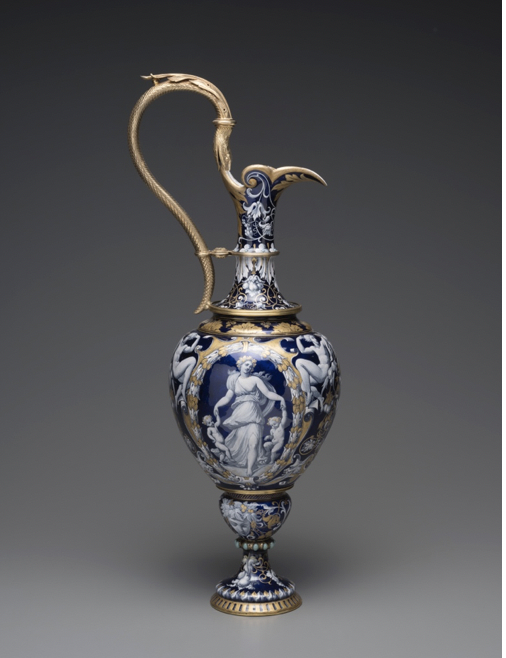
The Snite Museum added to its distinctive decorative arts holdings thanks to the generosity and foresight of the Virginia A. Marten family, whose longstanding support contributes to the University of Notre Dame’s teaching mission.
"The decorative arts have long played an important role in the Museum’s collecting and education programs; it is, therefore, a delight to welcome this exquisite Sèvres Limoges-style ewer into the permanent collection," said Snite Museum Director Joseph Antenucci Becherer. "The monumentality of this object and its exceptional condition exceed many expectations for the decorative arts, guaranteeing that it will soon become a Museum favorite," he added.
This most recent gift strengthens the holdings of decorative arts dating from the middle of the nineteenth century, a period when trends developed in response to the social and political upheaval prevalent at the time. At the forefront of those trends was a backlash against an increasingly industrialized society that led to a nostalgia for Medieval and Renaissance workshop productions and themes.
“This Sèvres Limoges-style ewer, long recognized as a masterpiece, reflects the intense interest in stylistic revivals at mid-century,” said Cheryl Snay, Curator of European and American Art before 1900. “The elegant grisaille cartouches depicting Venus and Flora, set against a dark blue ground highlighted with gold, hearken back to the glory days of the French Renaissance ushered in by Francis I.”
The Snite’s ewer complements several other works in the Museum’s collection, namely Edouard Pingret’s Troubadour painting of Diane de Poitier Receiving a Message from Francis I (1846), and the chalice designed by Charles-Eugène Trioullier (ca. 1850), also made in a Renaissance Revival style. Additionally, Eduard Steinbruck’s Adoration of the Magi (1838) was painted in a style meant to evoke the smooth, clear, sharp, enamel-like finish of Northern Renaissance artists.
Established in 1756, Sèvres is known for its porcelain wares. In the 1840s, the manufactory began experimenting with enamel, a technique that had flourished in the fifteenth and sixteenth centuries but had since declined. The director of Sèvres, Alexandre Brogniart, invited the Parisian enameller Jacob Meyer-Heine to the manufactory to experiment with “new” forms and techniques. The results were successful, and Meyer-Heine was hired by Sèvres to produce Renaissance Revival, Limoges-style enamel wares. Because the Snite’s ewer with its distinctive grisaille decoration was among the first to come off the production line, it was featured in exhibitions and was well documented in the press.
Sèvres Enamel Ewer, 1849
Enamel on copper with gilt-metal mount
24.4 x 10 inches, Virginia A. Marten Endowment for Decorative Arts Fund, 2020.004
MEDIA CONTACT: If you would like high-resolution images or in-depth information, please contact Gina Costa, Marketing and Public Relations Program Manager, at (574) 631-4720 or gcosta@nd.edu